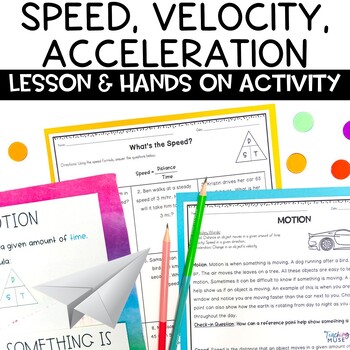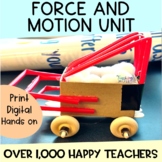Speed Velocity and Acceleration Activity
- PDF
- Google Apps™

What educators are saying
Also included in
- Teach your students about force and Newton's Laws of Motion using over one hundred pages of hands on activities, demonstrations, classroom posters, science text, STEM projects, and an assessment to complete your physical science unit. It will teach and assess your students about different forces andPrice $35.00Original Price $46.49Save $11.49
- Looking for easy to implement units of study for your physical science curriculum? These activities will help students learn about electricity, magnetism, forms of energy, force and Newton's laws of motion, and simple machines. This curriculum includes science texts, projects, classroom posters, cooPrice $100.00Original Price $117.93Save $17.93
Description
Teach students about speed, velocity, and acceleration with this science lesson and hands-on paper airplane activity. This lesson will teach students what speed, velocity, and acceleration are, the formulas used to calculate motion, and have students review their learning through the flying of paper airplanes. In addition, students will learn how to measure motion through the activities in this lesson.
Students will learn:
- The definition, examples, and formula used to calculate speed, velocity, and acceleration
This science lesson includes:
- Sneek Peek into My Classroom: Tips and ideas to implement this lesson into your classroom from my experience using it with my students.
- Digital and hands-on lab instructions
- Measuring Motion Teacher Presentation
- Measuring Motion Student Fill in Note Sheet
Print and Digital companions for the following activities:
- Speed, Velocity, and Acceleration Reading Packet - Includes 4 pages of science text, check-in questions, and overall comprehension questions.
- Speed Word Problems
- Acceleration Word Problems
Print Only Options:
- Paper Airplane Lab - This lab includes paper airplane templates and will review student knowledge of measuring motion.
- Word Search
- Answer Key
How to use this lesson in your science classroom:
- Teacher presentation: Start your unit using this presentation to walk students through the definitions, examples, and formulas for speed, velocity, and acceleration.
- Student fill-in notes: As students listen to the discussion provided with the teacher's presentation, they will take guided notes that they can later reference from their science notebooks.
- Reading packet: Great for students who need extra guidance or use as sub plans, the reading packet will provide students with step-by-step instruction as they read to learn about speed, velocity, and acceleration.
- Word Problems: Use these activities to practice using the formula to measure motion.
- Paper Airplane Lab: Get hands-on and solidify learning by having students complete the paper airplane lab. Students will work in groups to measure and determine the airplanes' speed, velocity, and acceleration. Paper airplane templates are included!
- Word Search: Perfect for fast finishers or sub plans. A word search is included to review vocabulary associated with measuring motion.
Teacher Feedback:
- This will fit in perfectly with my force and motion unit for my high fliers who need just a little bit more. I love being able to pull math into science in practical ways.
- My students loved using this resource! It was very engaging!
- My kids really enjoyed these notes, they were simple yet effective! Thanks for a great resource!
Other lessons and activities you might be interested in:
Kindly Note: If you have questions, do not hesitate to email me at Teaching Muse's Email
PLEASE PREVIEW BEFORE PURCHASING
__________________________________________________________________
Thank you for visiting Teaching Muse. I would love for you to become a follower.
Teaching Muse followers receive new product information and discounts on any new items!
__________________________________________________________________
All rights reserved by Teaching Muse. This product is to be used by the original downloader ONLY. Copying for more than one teacher, classroom, department, school, or school system is prohibited. Additionally, this product may not be distributed or displayed digitally for public view. Failure to comply is a copyright infringement and violates the Digital Millennium Copyright Act (DMCA). They are intended for classroom and personal use ONLY.







